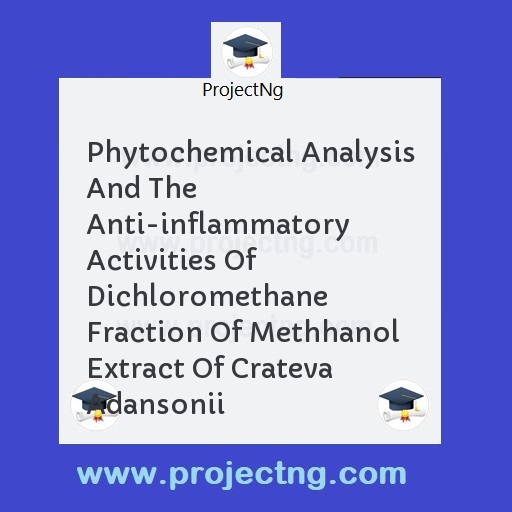Phytochemical Analysis And The Anti-inflammatory Activities Of Dichloromethane Fraction Of Methhanol Extract Of Crateva Adansonii
Bio-chemistry Project Topics
Get the Complete Project Materials Now! »
ABSTRACT
Inflammation is a complex biological response of vascular tissue to harmful stimuli such as pathogen, damage cells or irritants (Ryan & Majno, 1983). The urgency generated by increased rate of stroke, atherosclerosis attribute due to prolonged use of cyclooxygenase-1 and Cyclooxygenase- 2 inhibitors have accelerated anti-inflammatory drug research over the last decade while synthetic pharmaceutical agents continued to dominate research (Ryan & Majno, 1983). Attention increasingly has been directed to natural products. These are often more affordable and available and sometimes are perceived as more effective than conventional anti- inflammatory drugs.
Anti-inflammation was carried out using 12 rats which was divided into three groups of 4 rats each. Group 1 and 2 served as the negative and positive control respectively. Group 3 received 25mg/kg b.w. of the dichloromethane fraction of methanol extract of
6
Crateva adansonii showed significance anti-inflammatory activity when compared with the standard difference used.
TABLE OF CONTENT
Title page………………………………………………………………… i
Certification……………………………………………………………. ii
Dedication………………………………………………………………. iii
Acknowledgement…………………………………………………. iv
Abstract……………………………………………………………….... v
Table of Content…………………………………………………… vi
CHAPTER ONE
1.1 Introduction ………………………………………………… 1
7
1.2 Crateva adansonii as a plant..……………………. 4
1.3 Research aim and objectives……………………... 7
CHAPTER TWO
LITERATURE REVIEW
2.0 Definition of Inflammation…………………….. 8
2.1 Characteristics of Inflammation………………. 8
2.2 Classes of Inflammation………………………… 9
2.3 Types of Inflammation……………………………. 10
2.4 Chemical mediators of Inflammation………… 13
2.4.0 Properties of Mediators……………………….. 16
8
2.4.1 Histamine………………………………………… 18
2.4.2 Serotonin (5- Hydroxy tryptamine)………… 21
2.4.3 Cytokines………………………………………………….. 24
2.4.4 Arachidonic acid ……………………………………… 30
2.4.5 Platelet Activating Factor (PAF)……………… 34
2.4.6 Free Radicals……………………………………. 36
2.4.6.1 Nitric Oxide (NO)……………………………… 37
2.4.6.2 Oxygen-derived free radicals………………. 40
2.4.7.0 Complement system…………………………. 41
9
2.4.7.1 The clotting system/Coagulation system. 45
2.4.7.2 The Kinin System……………………………. 48
2.4.7.3 The fibrinolytic system……………………… 50
2.5.0 Anti-Inflammatory agents………………….. 53
2.5.1 Non-steroidal Anti-inflammatory Drugs (NSAIDS) 53
2.5.1.0 Mechanism of Action of NSAIDS…………. 55
2.5.2 Steroidal Anti-inflammatory drugs……….. 58
CHAPTER THREE
MATERIAL AND METHODS
3.1 Materials……………………………………………… 60
10
3.1.1 Equipment/Apparatus used…………………… 60
3.1.2 Chemical, Solvents and Reagents…………….. 61
3.1.3 Animals………………………………………………….. 62
3.2 Methodology………………………………………………. 63
3.2.1 Collection and preparation of Plant Materials….. 63
3.2.2 Extraction………………………………………………... 63
3.3 Fractionation……………………………………………… 64
3.3.1 Gel Column Chromatography………………………. 64
3.4. Identification of Phytochemical groups
in the extract……………………………………………. 65
3.4.1 Preparation of Reagents for phytochemical
11
analysis……………………………………………………. 65
3.4.2 Qualitative phytochemical analysis
of the Extract……………………………………………. 66
3.5 Thin Layer Chromatography………………………… 71
3.6 Anti-inflammatory activity test. …………………… 72
CHAPTER FOUR
Result……………………………………………………………. 75
CHAPTER FIVE
Discussion……………………………………………………… 79
Conclusion……………………………………………………… 81
References………………………………………………………. 82
Appendixes……………………………………………… 87
12
CHAPTER ONE
INTRODUCTION AIM AND OBJECTIVES
Inflammation is one of body’s natural ways of protecting itself. It is also an essential reaction of the body to infection. Too little of an inflammatory response, and the body is unable to repel microbial invasions or heal injuries. Too much of an inflammatory response, and the immune system begins attacking the body’s own organs eventually leading to chronic disease (Sears, 2000).
Anti-Inflammatory refers to the property of a substance or treatment that reduces inflammation. There are obvious clinical markers of inflammation which include pain, redness, fever, swelling and loss of function (Pai et al. 2004). However if inflammation is allowed to continue unchecked it may results in neurodegenerative disease or cancer (Pai et al. 2004). A variety of safe and effective anti-inflammatory agents are available including non-steroidal anti-inflammatory drugs, corticosteroids.
Be the First to Share On Social

Enjoying our content?
Don't miss out on new videos! Subscribe to our YouTube channel for more awesome content.
Subscribe Now!













